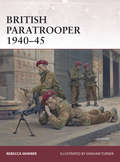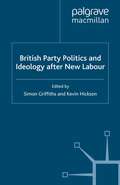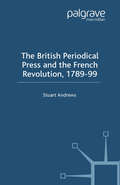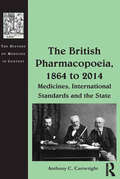- Table View
- List View
British Pamphlets on the American Revolution, 1763-1785, Part II, Volume 6
by Harry T DickinsonFirst published in 2007, this collection presents a selection of British pamphlets, which represent the multi-faceted debate on both sides of the political divide in Britain. The pamphlets in this work are organised chronologically in two parts, taking the start of American armed resistance in 1775 as the dividing point. Volume 6 starts Part II and covers the period of 1778.
British Pamphlets on the American Revolution, 1763-1785, Part II, Volume 6
by Harry T DickinsonFirst published in 2007, this collection presents a selection of British pamphlets, which represent the multi-faceted debate on both sides of the political divide in Britain. The pamphlets in this work are organised chronologically in two parts, taking the start of American armed resistance in 1775 as the dividing point. Volume 6 starts Part II and covers the period of 1778.
British Pamphlets on the American Revolution, 1763-1785, Part II, Volume 7
by Harry T DickinsonFirst published in 2007, this collection presents a selection of British pamphlets, which represent the multi-faceted debate on both sides of the political divide in Britain. The pamphlets in this work are organised chronologically in two parts, taking the start of American armed resistance in 1775 as the dividing point. Volume 7 is in Part II and covers the period of 1779 to1782.
British Pamphlets on the American Revolution, 1763-1785, Part II, Volume 7
by Harry T DickinsonFirst published in 2007, this collection presents a selection of British pamphlets, which represent the multi-faceted debate on both sides of the political divide in Britain. The pamphlets in this work are organised chronologically in two parts, taking the start of American armed resistance in 1775 as the dividing point. Volume 7 is in Part II and covers the period of 1779 to1782.
British Pamphlets on the American Revolution, 1763-1785, Part II, Volume 8
by Harry T DickinsonFirst published in 2007, this collection presents a selection of British pamphlets, which represent the multi-faceted debate on both sides of the political divide in Britain. The pamphlets in this work are organised chronologically in two parts, taking the start of American armed resistance in 1775 as the dividing point. Volume 8 covers the period of 1783 to1785 and includes a consolidated index.
British Pamphlets on the American Revolution, 1763-1785, Part II, Volume 8
by Harry T DickinsonFirst published in 2007, this collection presents a selection of British pamphlets, which represent the multi-faceted debate on both sides of the political divide in Britain. The pamphlets in this work are organised chronologically in two parts, taking the start of American armed resistance in 1775 as the dividing point. Volume 8 covers the period of 1783 to1785 and includes a consolidated index.
British Pan-Arab Policy, 1915-1922
by Isaiah FriedmanIn this myth-shattering study Isaiah Friedman provides a new perspective on events in the Middle East during World War I and its aftermath. He shows that British officials in Cairo mistakenly assumed that the Arabs would rebel against Turkey and welcome the British as deliverers. Sharif (later king) Hussein did rebel, but not for nationalistic motives as is generally presented in historiography. Early in the war he simultaneously negotiated with the British and the Turks but, after discovering that the Turks intended to assassinate him, finally sided with the British. There was no Arab Revolt in the Fertile Crescent. It was mainly the soldiers of Britain, the Commonwealth, and India that overthrew the Ottoman rule, not the Arabs. Both T.E. Lawrence ("Lawrence of Arabia") and Sir Mark Sykes hoped to revive the Arab nation and build a new Middle East. They courted disappointment: the Arabs resented the encroachment of European Powers and longed for the return of the Turks. Emir Feisal too became an exponent of Pan-Arabism and a proponent of the "United Syria" scheme. It was supported by the British Military Administration who wished thereby to eliminate the French from Syria. British officers were antagonistic to Zionism as well and were responsible for the anti-Jewish riots in Jerusalem in April 1920. During the twenties, unlike the Hussein family and their allies, the peasants (fellaheen), who constituted the majority of the Arab population in Palestine, were not inimical towards the Zionists. They maintained that "progress and prosperity lie in the path of brotherhood" between Arabs and Jews and regarded Jewish immigration and settlement to be beneficial to the country. Friedman argues that, if properly handled, the Arab-Zionist conflict was not inevitable. The responsibility lay in the hands of the British administration of Palestine.
British Pan-Arab Policy, 1915-1922
by Isaiah FriedmanIn this myth-shattering study Isaiah Friedman provides a new perspective on events in the Middle East during World War I and its aftermath. He shows that British officials in Cairo mistakenly assumed that the Arabs would rebel against Turkey and welcome the British as deliverers. Sharif (later king) Hussein did rebel, but not for nationalistic motives as is generally presented in historiography. Early in the war he simultaneously negotiated with the British and the Turks but, after discovering that the Turks intended to assassinate him, finally sided with the British. There was no Arab Revolt in the Fertile Crescent. It was mainly the soldiers of Britain, the Commonwealth, and India that overthrew the Ottoman rule, not the Arabs. Both T.E. Lawrence ("Lawrence of Arabia") and Sir Mark Sykes hoped to revive the Arab nation and build a new Middle East. They courted disappointment: the Arabs resented the encroachment of European Powers and longed for the return of the Turks. Emir Feisal too became an exponent of Pan-Arabism and a proponent of the "United Syria" scheme. It was supported by the British Military Administration who wished thereby to eliminate the French from Syria. British officers were antagonistic to Zionism as well and were responsible for the anti-Jewish riots in Jerusalem in April 1920. During the twenties, unlike the Hussein family and their allies, the peasants (fellaheen), who constituted the majority of the Arab population in Palestine, were not inimical towards the Zionists. They maintained that "progress and prosperity lie in the path of brotherhood" between Arabs and Jews and regarded Jewish immigration and settlement to be beneficial to the country. Friedman argues that, if properly handled, the Arab-Zionist conflict was not inevitable. The responsibility lay in the hands of the British administration of Palestine.
British Paratrooper 1940–45 (Warrior)
by Rebecca Skinner Mr Graham TurnerInspired by the exploits of the German Fallschirmjäger in the blitzkrieg campaigns, Winston Churchill called for the formation of a 5,000-strong Airborne Force in June 1940. From these beginnings The Parachute Regiment became one of the foremost units of the British Army both in World War II and up to the present day. This new history of the British Paratrooper, from 1940 to 1945, details the unique training, weapons and equipment used by these elite troops. A wealth of first-hand and until now unpublished materials brings the history of the ordinary paratrooper to life, drawing on the author's position as a former curator of the Regimental Museum. Illustrations and photographs illuminate the equipment and combat performance of the elite 'Paras' in the context of some of the most significant campaigns of World War II, including D-Day and Operation Market-Garden.
British Paratrooper 1940–45 (Warrior)
by Graham Turner Rebecca SkinnerInspired by the exploits of the German Fallschirmjäger in the blitzkrieg campaigns, Winston Churchill called for the formation of a 5,000-strong Airborne Force in June 1940. From these beginnings The Parachute Regiment became one of the foremost units of the British Army both in World War II and up to the present day. This new history of the British Paratrooper, from 1940 to 1945, details the unique training, weapons and equipment used by these elite troops. A wealth of first-hand and until now unpublished materials brings the history of the ordinary paratrooper to life, drawing on the author's position as a former curator of the Regimental Museum. Illustrations and photographs illuminate the equipment and combat performance of the elite 'Paras' in the context of some of the most significant campaigns of World War II, including D-Day and Operation Market-Garden.
British Paratrooper vs Fallschirmjäger: Mediterranean 1942–43 (Combat)
by Johnny Shumate David GreentreeThe airborne forces of Britain and Germany were among their best troops of World War II and when they met in battle the result was a brutal trial of strength. British paratroopers and German Fallschirmjäger clashed repeatedly and their training, tactics, experience, morale and weaponry were tested against each other, not least in the three bruising encounters outlined here, in Tunisia and Sicily. From the British attempts to seize the airfields at Depienne and Oudna to the bloody night battle for Green Hill and the bitter struggle for Primosole Bridge in Sicily, these highly trained parachute troops clashed with their opposite numbers, gaining experience, refining tactics and learning valuable lessons.
British Paratrooper vs Fallschirmjäger: Mediterranean 1942–43 (Combat #1)
by Johnny Shumate David GreentreeThe airborne forces of Britain and Germany were among their best troops of World War II and when they met in battle the result was a brutal trial of strength. British paratroopers and German Fallschirmjäger clashed repeatedly and their training, tactics, experience, morale and weaponry were tested against each other, not least in the three bruising encounters outlined here, in Tunisia and Sicily. From the British attempts to seize the airfields at Depienne and Oudna to the bloody night battle for Green Hill and the bitter struggle for Primosole Bridge in Sicily, these highly trained parachute troops clashed with their opposite numbers, gaining experience, refining tactics and learning valuable lessons.
British Parliamentary Lists, 1660-1880
by G. M. DitchfieldThis register identifies all known lists - division lists, forecasts, management and propaganda lists - for the House of Commons between 1660 and 1761, for the House of Lords between 1660 and 1800, and for the Scottish Parliament between 1660 and 1707. The listing has been updated since the previous "Register of Parliamentary Lists" in 1979. It may also be a useful adjunct to Donald E. Ginter's Voting Records of the British House of Commons, 1761-1820.
British Party Politics, 1852–1886
by Angus HawkinsBetween 1852 and 1886 British politics moved from a system of 'parliamentary government' towards a two party system. This book looks at why and how this change happened and analyses the long-term implications it had for British politics.
British Party Politics and Ideology after New Labour
by S. Griffiths K. HicksonBritish Party Politics and Ideology after New Labour brings together academics and politicians to debate the intellectual roots of the ideas that currently drive the main UK political parties. With major players responding to the arguments raised in each chapter, the book will be a must-read for anyone interested in or teaching British politics.
British Paternalism and Africa, 1920–1940 (Routledge Revivals)
by Penelope HetheringtonBritish Paternalism and Africa (1978) is a study of the beliefs and assumptions of members of the British intelligentsia who concerned themselves with British–African politics in the period between the wars. The journals and books published in Britain during this period were used as source material to discover the attitudes of politicians, missionaries, administrators and others concerning ‘African’ issues. In the two decades before the Second World War the debate about the future of the African colonies still seemed to be the preserve of Europeans, anxious to influence British politics according to their own particular brand of paternalism. It is argued that some writers still used arguments about Britain’s ‘civilizing’ mission, while others emphasised the need for a period of reconstruction of African society, to be carried out before independence could be granted. Only the Marxist-Leninist writers rejected doctrines which implied the necessity for continued European presence in Africa.
British Paternalism and Africa, 1920–1940 (Routledge Revivals)
by Penelope HetheringtonBritish Paternalism and Africa (1978) is a study of the beliefs and assumptions of members of the British intelligentsia who concerned themselves with British–African politics in the period between the wars. The journals and books published in Britain during this period were used as source material to discover the attitudes of politicians, missionaries, administrators and others concerning ‘African’ issues. In the two decades before the Second World War the debate about the future of the African colonies still seemed to be the preserve of Europeans, anxious to influence British politics according to their own particular brand of paternalism. It is argued that some writers still used arguments about Britain’s ‘civilizing’ mission, while others emphasised the need for a period of reconstruction of African society, to be carried out before independence could be granted. Only the Marxist-Leninist writers rejected doctrines which implied the necessity for continued European presence in Africa.
The British people and the League of Nations: Democracy, citizenship and internationalism, c.1918–45 (PDF)
by Helen MccarthyIn the decades following Europe’s first total war, millions of British men and women looked to the League of Nations as the symbol and guardian of a new world order based on international co-operation. Founded in 1919 to preserve peace between its member-states, the League inspired a rich, participatory culture of political protest, popular education and civic ritual which found expression through the establishment of voluntary societies in dozens of countries across Europe and beyond. Embodied in the hugely popular League of Nations Union, this pro-League movement touched Britain in profound ways. Foremost amongst the League societies, the Union became one of Britain’s largest voluntary associations and a powerful advocate of democratic accountability and popular engagement in the making of foreign policy. Based on extensive archival research, The British people and the League of Nations offers a vivid account of this popular League consciousness and in so doing reveals the vibrant character of associational life between the wars.
The British people and the League of Nations: Democracy, citizenship and internationalism, c.1918–45
by Helen MccarthyIn the decades following Europe’s first total war, millions of British men and women looked to the League of Nations as the symbol and guardian of a new world order based on international co-operation. Founded in 1919 to preserve peace between its member-states, the League inspired a rich, participatory culture of political protest, popular education and civic ritual which found expression through the establishment of voluntary societies in dozens of countries across Europe and beyond. Embodied in the hugely popular League of Nations Union, this pro-League movement touched Britain in profound ways. Foremost amongst the League societies, the Union became one of Britain’s largest voluntary associations and a powerful advocate of democratic accountability and popular engagement in the making of foreign policy. Based on extensive archival research, The British people and the League of Nations offers a vivid account of this popular League consciousness and in so doing reveals the vibrant character of associational life between the wars.
The British Periodical Press and the French Revolution 1789-99
by S. AndrewsThis study challenges the conventional polarities used to describe British politics of the 1790s; Pitt versus Fox, Burke versus Paine, Church versus Dissent, ruling class versus working class, Jacobin versus anti-Jacobin. Such polarities were sedulously promoted by Pitt's wartime government, which applied 'Jacobin' shamelessly to all its critics and opponents, and thus foreshadowed the McCarthyite tactic of guilt by association. The author seeks to make the less strident but more persuasive contemporary voices again audible. He takes seriously those who questioned the necessity for Burke's crusade to destroy the French republic, and who deplored Britain's alliance with the partitioners of Poland.
British Periodicals and Romantic Identity: The "Literary Lower Empire" (Nineteenth-Century Major Lives and Letters)
by M. SchoenfieldWhen Lord Byron identified the periodical industry as the "Literary Lower Empire," he registered the cultural clout that periodicals had accumulated by positioning themselves as both the predominant purveyors of scientific, economic, and social information and the arbiters of literary and artistic taste. British Periodicals and Romantic Identity explores how periodicals such as the Edinburgh, Blackwood s, and the Westminster became the repositories and creators of "public opinion." In addition, Schoenfield examines how particular figures, both inside and outside the editorial apparatus of the reviews and magazines, negotiated this public and rapidly professionalized space. Ranging from Lord Byron, whose self-identification as lord and poet anticipated his public image in the periodicals, to William Hazlitt, equally journalist and subject of the reviews, this engaging study explores both canonical figures and canon makers in the periodicals and positions them as a centralizing force in the consolidation of Romantic print culture.
The British Pharmacopoeia, 1864 to 2014: Medicines, International Standards and the State (The History of Medicine in Context)
by Anthony C. CartwrightThe British Pharmacopoeia has provided official standards for the quality of substances, medicinal products and articles used in medicine since its first publication in 1864. It is used in over 100 countries and remains an essential global reference in pharmaceutical research and development and quality control. This book explores how these standards have been achieved through a comprehensive review of the history and development of the pharmacopoeias in the UK, from the early London, Edinburgh and Dublin national pharmacopoeias to the creation of the British Pharmacopoeia and its evolution over 150 years. Trade in medicinal substances and products has always been global, and the British Pharmacopoeia is placed in its global context as an instrument of the British Empire as it first sought to cover the needs of countries such as India and latterly as part of its role in international harmonisation of standards in Europe and elsewhere. The changing contents of the pharmacopoeias over this period reflect the changes in medical practice and the development of dosage forms from products dispensed by pharmacists to commercially manufactured products, from tinctures to the latest monoclonal antibody products. The book will be of equal value to historians of medicine and pharmacy as to practitioners of medicine, pharmacy and pharmaceutical analytical chemistry.
The British Pharmacopoeia, 1864 to 2014: Medicines, International Standards and the State (The History of Medicine in Context)
by Anthony C. CartwrightThe British Pharmacopoeia has provided official standards for the quality of substances, medicinal products and articles used in medicine since its first publication in 1864. It is used in over 100 countries and remains an essential global reference in pharmaceutical research and development and quality control. This book explores how these standards have been achieved through a comprehensive review of the history and development of the pharmacopoeias in the UK, from the early London, Edinburgh and Dublin national pharmacopoeias to the creation of the British Pharmacopoeia and its evolution over 150 years. Trade in medicinal substances and products has always been global, and the British Pharmacopoeia is placed in its global context as an instrument of the British Empire as it first sought to cover the needs of countries such as India and latterly as part of its role in international harmonisation of standards in Europe and elsewhere. The changing contents of the pharmacopoeias over this period reflect the changes in medical practice and the development of dosage forms from products dispensed by pharmacists to commercially manufactured products, from tinctures to the latest monoclonal antibody products. The book will be of equal value to historians of medicine and pharmacy as to practitioners of medicine, pharmacy and pharmaceutical analytical chemistry.
British Philanthropy in the Globalizing World: Entrepreneurs and Evangelicals, 1756-1840 (Oxford Historical Monographs)
by Dr Roshan AllpressBetween 1756 and 1840, philanthropy in the British world grew from the domain of small, associational committees to a vast enterprise of philanthropic and humanitarian societies with global reach. British Philanthropy in the Globalizing World tells the story of this movement, from its inception in small networks of mercantile and religious entrepreneurs to its signal projects and achievements in the abolition of slavery, in evangelical missionary societies, Bible societies, and in the early indigenous rights movement. It traces the lives and networks of hundreds of philanthropists across four generations, showing how their social, religious, economic, intellectual, and cultural worlds intersected to foster philanthropic innovation through organisational models, transnational networks, and the creation of a unique formative culture. It shows how groups such as the Clapham Sect — including William Wilberforce, Henry Thornton, Hannah More, James Stephen, and others — emerged in an intergenerational context, and how they sought to effect social and cultural change across multiple spheres. For every headline achievement, there were many failed experiments, inner wrestlings, and long-running intellectual collaborations that left a wide and deep imprint on the cultural and political landscape of the English-speaking world. Drawing on the separate historiographies of metropolitan philanthropy, associational culture, anti-slavery, moral reform, Evangelicalism, colonial missions, and economic thought, the study unites into one analytical frame both the imaginative and organizational realities of philanthropy, offering a dual focus on individual philanthropists — their inner lives, daily practices, and participation in collaborative communities — and on mapping the networks that bound philanthropic societies and projects together in metropolitan London and at the far reaches of the British world. In doing so, it offers a very human portrait of these entrepreneurs and evangelicals, as they pursued a philanthropic global vision.
British Philanthropy in the Globalizing World: Entrepreneurs and Evangelicals, 1756-1840 (Oxford Historical Monographs)
by Dr Roshan AllpressBetween 1756 and 1840, philanthropy in the British world grew from the domain of small, associational committees to a vast enterprise of philanthropic and humanitarian societies with global reach. British Philanthropy in the Globalizing World tells the story of this movement, from its inception in small networks of mercantile and religious entrepreneurs to its signal projects and achievements in the abolition of slavery, in evangelical missionary societies, Bible societies, and in the early indigenous rights movement. It traces the lives and networks of hundreds of philanthropists across four generations, showing how their social, religious, economic, intellectual, and cultural worlds intersected to foster philanthropic innovation through organisational models, transnational networks, and the creation of a unique formative culture. It shows how groups such as the Clapham Sect — including William Wilberforce, Henry Thornton, Hannah More, James Stephen, and others — emerged in an intergenerational context, and how they sought to effect social and cultural change across multiple spheres. For every headline achievement, there were many failed experiments, inner wrestlings, and long-running intellectual collaborations that left a wide and deep imprint on the cultural and political landscape of the English-speaking world. Drawing on the separate historiographies of metropolitan philanthropy, associational culture, anti-slavery, moral reform, Evangelicalism, colonial missions, and economic thought, the study unites into one analytical frame both the imaginative and organizational realities of philanthropy, offering a dual focus on individual philanthropists — their inner lives, daily practices, and participation in collaborative communities — and on mapping the networks that bound philanthropic societies and projects together in metropolitan London and at the far reaches of the British world. In doing so, it offers a very human portrait of these entrepreneurs and evangelicals, as they pursued a philanthropic global vision.

















